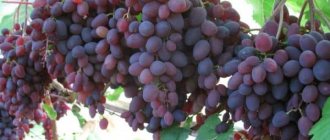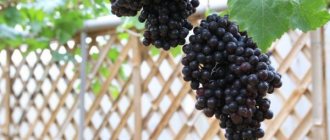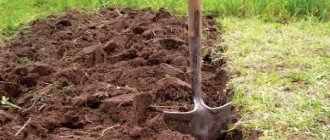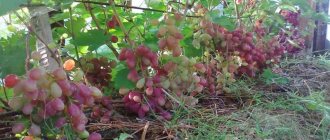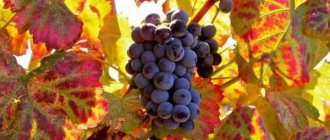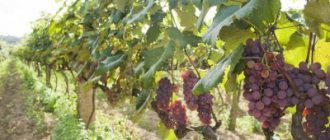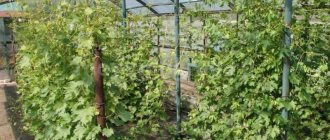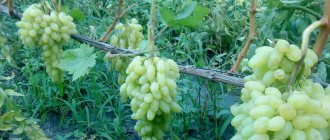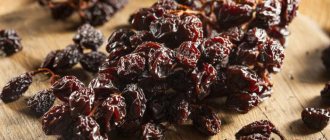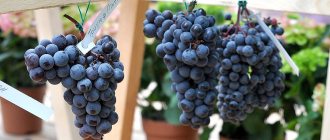Advantages and disadvantages
Like any other variety, “Kishmish radiata” has its own advantages and disadvantages.”
Pros:
- Lack of seeds inside the berries.
- Fragrant and sweet pulp.
- Excellent appearance of the bunches.
- Relatively high yield.
- Good shelf life and transportation properties.
- Using a bush as an element of landscape design.
Minuses:
- The need for mandatory crop rationing and bush pruning.
- Low frost resistance.
- Tendency to infection with fungal infections and phylloxera.
conclusions
Kishmish radiata grapes are a very healthy and tasty berry. Caring for it is meticulous, but it pays off with huge yields.
- Kishmish radiata - large clusters, pink in color. They have no bones, and the taste is mild, semi-sour, with light notes of nutmeg.
- The vine is flexible, but requires serious gartering on a trellis, as it can break under the weight of ripe bunches.
- The radiata variety is no exception to other types of grapes and is susceptible to all fungal infections, and wasps are also very fond of it.
- Pruning and fertilizing should be regular: in spring and autumn, then the yield will be high and stable.
Origin
As a result of crossing “pink sultana” and “cardinal”, a new seedless variety with excellent characteristics appeared - “radiant sultana”. The grapes received such a romantic name because of the peculiarity of the berries with thin skin and light pulp inside, allowing sunlight to pass through, which is why they begin to “beam”, glow from the inside.
A successful experiment was carried out in Moldova at the Vierul Research Institute for Viticulture and Winemaking thanks to the efforts of breeders I. P. Gavrilov, M. S. Zhuravel and G. N. Borzikov.
Parents of “Kishmish radiata” – “Kishmish pink” and “Cardinal”
Productivity and ripening time
The plant produces its first signal harvest in the 2nd year after planting, marketable fruiting begins in the 4th - on average 12-15 kg per bush.
According to the results of experimental tests in the natural conditions of the eastern upland-steppe region of the South Coast (in a non-covered culture, planting scheme 3x2.5 m with a standardless fan formation), five-year-old plantings demonstrated a yield of 7.8-8.1 t/ha.
In industrial plantings of Crimea, the variety proved to be high-yielding - more than 8 t/ha
Removable maturity occurs 121-135 days after bud break. In the south this is approximately the third ten days of August, in the central zone - the beginning of September. If the vine is overloaded, the ripening period increases by 10-20 days. The longer the clusters hang on the bush, the better the quality of the fruit will be. If collected in a timely and competent manner, they do not spoil and are stored well in the refrigerator for more than 2 months. The juicy seedless pulp is reliably protected from damage by a durable skin, which is practically not injured during transportation. A special feature of the variety is the strong attachment of the berry to the stalk, which has a positive effect on the keeping quality of the fruit, so it is recommended primarily for industrial cultivation for commercial purposes.
The opinion of an experienced Ukrainian gardener about the yield potential can be found in the following video:
Main characteristics
“Kishmish radiata” is a seedless grape of medium-early ripening with huge clusters of golden-pink color.
Ripening period
The duration of the plant's growing season from the beginning of sap flow to the moment of harvesting is 120 - 140 days , which allows us to consider “radiant raisins” to be medium-early in terms of ripening. The beginning of harvesting work is the end of August - the beginning of September, depending on the region of grape cultivation and weather conditions.
Bush
The grape bush “Kishmish radiata” is vigorous, the shoots develop quite quickly. To support powerful vines, single-strip trellises should not be used: experienced winegrowers use fan forming, a cordon of 2 or 4 shoulders. You can also grow this variety using special arches or arbors as a support: with this arrangement, the brushes hang freely, are evenly illuminated by the sun and blown by the wind, which helps prevent the development of fungal infections.
The leaves of the variety are medium-sized, five-lobed, heart-shaped, colored in a rich green color. The flowers are unisexual and pollinate the female inflorescences.
Bunches and berries
The variety's clusters are very large, their length can reach 45–50 centimeters, and their weight can range from 450 to 900 grams. The shape of the brush is conical, the structure of the brush is dense.
The berries of the variety are oval in shape, elongated, they are painted in a pleasant pink color with a reddish-golden core. Average parameters of grapes: weight – 4 grams, length – 22 mm, width – 16 – 18 mm. The pulp is juicy, fleshy, seedless, but in the largest specimens you can find soft rudiments. The skin is dense, but does not interfere with chewing. The sugar content of “Kishmish radiata” is 18 – 22%, acidity – 6.5 – 7.5 g/l.
Taste and yield
The taste of the berries is pleasant, it harmoniously combines sweetness and light notes of nutmeg and freshness. The variety has a good yield of up to 20 kilograms per bush or up to 150 centners per hectare.
Attention! “Kishmish radiant” is resistant to shedding. Even a fully ripe brush can be left hanging on the bush - the presentation will not be lost, and the taste characteristics will only improve.
Description of the plant and specifics of cultivation
The vine has medium vigor and well-ripening shoots. The perennial parts of the bush are covered with reddish, coarse-fibrous bark. The leaves are simple, medium-sized, round, five-lobed, moderately and strongly dissected, light green, shiny above, without pubescence below. The upper lateral notches are open, arched or elliptical, the lower ones are barely outlined. The petiole notch is open, V-shaped. The teeth at the ends of the blades are narrow, and the lateral ones have a wide base. The flowers are greenish, small (3-5 mm in diameter), bisexual. For "Kishmish radiata" there is no need to select additional pollinators.
Bushes are weak-growing, with well-ripening shoots
Fruitful shoots range from 68 to 80%, the average load per each is 1.3 bunches (maximum - 1.6). The most developed shoots are left for fruiting. The quality of the future harvest directly depends on the length of pruning of the fruit shoots. To obtain a stable and high-quality harvest, experts recommend medium pruning (6-8 buds). In this case, the optimal load on the bush is considered to be 50-70 healthy eyes, that is, approximately 35-40 shoots. All weak and infertile ones are removed, leaving one of the best bunches. Timely harvest normalization reduces the likelihood of obtaining unripe clusters with low-quality berries.
It is recommended to grow the bushes in a multi-armed fan (from 4 to
system, without boles. This formation allows you to easily cover the vine for the winter; due to the elasticity, the medium and long sleeves easily bend to the ground, and you can also leave a large load on the bush with its eyes.
Comparison with analogues
Comparative characteristics of the Kishmish Radiant grapes with other raisin varieties of pink grapes are presented below.
| Sign | Variety | |||
| Kishmish Radiant | Kishmish Dream | Veles | Relines pink seedlis | |
| Ripening period | 125 – 130 days | 120 – 130 days | 100 - 110 days | 105 – 115 days |
| Frost resistance | -15C | -20C | -23C | — 27C |
| Productivity | 15 – 20 kg | Up to 10 kg | 15 – 20 kg | 15 – 20 kg |
| Bunches | Up to 1 kg | 350 - 400 g | 600 g – 2 kg | 100 – 300 g |
| Taste | Nutmeg flavor | Sweet, harmonious | Muscat | Harmonious with a hint of lambrusco |
| Color | Hot pink | Deep pink | Pink - amber | Pink |
| Disease resistance | Above average | Below average | Above average | Above average |
| Shelf life | 3 months | Up to 3 months | Up to 3 months | 2 – 3 months |
| Sugar accumulation | 17 – 21% | 14 – 20% | 17 – 22% | 24% |
| Acidity | 6.5 – 7.5 g/l | 5 – 8 g/l | 5 - 7 g/l | 6 – 7 g/l |
Diseases and pests, methods of control and prevention
Radiant grapes are most susceptible to diseases such as mildew and oidium. To cure a plant or prevent the development of pathogenic microflora, Quadris and Ridomil Gold are used for treatment. Immediately after the onset of heat, the culture is treated with a solution of iron sulfate - 300 g per 10 liters of water.
Sultanas seedlings tolerate diseases worse than adult specimens, so special attention should be paid to their protection. The following are also used for spraying:
- "Fundazol";
- "Aktellik";
- "Fufafon."
Important! Regardless of the condition of the plant, treatment is stopped no later than a month before harvesting.
Useful properties and applications
A number of facts indicate the undoubted benefits of the variety for the human body:
- The main part of the beneficial elements and compounds is concentrated in the skin of the grapes: the richer their color, the greater their quantity.
- The pink shell of “sultana radiata” contains a high percentage of reveratrol, a unique component that actively fights dangerous cancer cells.
- A small handful of these grapes can relieve an attack of irritability, overcome an attack of fatigue, or simply lift your spirits.
- Polyphenols and flavonoids help slow down the aging process of the body and reduce the negative impact of free radicals on it.
- An eaten bunch of berries will help eliminate problems in bone tissue and cartilage.
- Grapes activate the gastrointestinal tract and help cope with the symptoms of intoxication.
- The variety has a positive effect on blood composition, the condition of blood vessels and the heart.
- A large number of useful elements in the composition speed up the recovery process after a serious illness, and is also a good way to strengthen the immune system.
Reference! The calorie content of pink varieties of “kishmish” is about 80 – 90 kcal per 100 g of product. A safe “dose” of this tasty, but high-calorie berry is 20 – 25 grapes per day. This amount will prevent the development of unwanted side effects in the body, as well as the accumulation of extra pounds.
“ Kishmish radiant” is good for making wine, compote and juice. You can decorate dishes with it or use it as an ingredient in fruit and vegetable salads. Well, like any “raisin”, this variety can be used to produce raisins. The variety is also ideal for fresh consumption.
Tips from experienced winegrowers to improve the quality of pollination of bunches
Many winegrowers who have tried to grow “Kishmish Radiant” are faced with the problem of poor pollination and pea production of the variety. This is usually due to the fact that the pollination period of these grapes can be delayed for a period of 7 to 15 days. The methods for improving sultana pollination described in this section can also be used for other grape varieties with elongated clusters and a similar type of flowering.
- In order to increase the chances of complete pollination of the “Kishmish Radiant” bunches, you can spray with complex foliar fertilizers with a high content of zinc and phosphorus several days (3-5 days) before flowering. The onset of a suitable period is indicated by the “caps” dropped from the inflorescences.
- Also, in order to improve pollination and enlarge grape grains, a Gibberellin solution is used, strictly following the instructions for diluting the drug.
- Another very effective way to improve the pollination of bushes and make the berries larger without the use of special preparations is pinching. With this method, during flowering, the growing points on the vines are pinched and at the same time the tips of the bunches are plucked off by 1.0 or 1.5 centimeters.
Features of cultivation
“Kishmish radiant” differs from other varieties in that it is very unstable to frost, so it must be covered for the winter.
Landing
“Kishmish radiata” can be planted on the site both in spring and autumn. Spring planting work is usually carried out from April 20 to May 20, depending on the latitude of the region. During this period, the probability of return frosts is gradually reduced to zero, and the soil and air warm up to the required temperatures: +15ºС air and +10ºС soil.
In autumn, planting is carried out in October or early November, even before frost. If frosts strike suddenly, then the young seedlings must be immediately insulated using a cut plastic bottle or spruce branches.
Place and soil
The best place for “sultana radiata” is the most sunny and warm place, well protected from drafts and gusts of cold wind. It is not recommended to plant this variety near the walls of houses or next to tall trees: any shade will not allow the berries to fully ripen and the bush itself to develop safely.
The soil should preferably be fertile; black soil or loam is suitable. The distance between adjacent bushes should be at least 2.5 meters, and between rows - all 3 meters. It is also important to take into account the fact that the plant is a pollinator of female varieties, so the neighbor of “Kischmish radiata” should be exactly this type of grape (varieties “Lora”, “Red Delight”, “Flamingo”), blooming at the same time as it.
The planting technology is simple: the bottom of the planting hole (its dimensions are 40 by 80 cm and depth is 80 cm) is filled with ash and superphosphate, then with 25 cm of drainage (gravel, crushed stone, broken brick) and a mixture of sand, humus and fertile soil to the top . A meter-long pipe (diameter 5 cm) is driven into the southern side of the pit, and the length of its above-ground part should be about 5 cm, and an earthen mound in the form of a mound is made on its northern side. The seedling is placed in the center of the elevation, compacted and watered.
Watering and fertilizing
Kishmish loves water. It is recommended to water it 1 – 2 times a week, of course, provided there is no natural precipitation. The amount of moisture directly depends on the type of soil: 5-6 buckets of water are poured into chernozem, and 9 buckets into sandy soil. During the flowering of the plant and 2-3 weeks before harvesting, watering completely stops.
Reference! “Kishmish radiata” prefers drip irrigation, so it is advisable to install a similar irrigation system for each bush of this variety.
Fertilizing also plays an important role for the variety. During the active spring growing season, nitrogen fertilizers are used, which contribute to the growth of green mass. After the formation of the 3rd leaf, as well as before flowering and during the formation of the fruit ovary, it is advisable to apply magnesium sulfate, potassium sulfate and monophosphate under the root, taking into account the composition and reaction of the soil, since an excess of any mineral will negatively affect the grapes.
You should not be zealous: from an excessive amount of fertilizing, the plant can simply “get fat”, as a result of which the beginning of flowering will be delayed, and the ovaries will form poorly.
Many winegrowers use Plantofol foliar feeding, which is applied strictly according to the instructions. This is a complex fertilizer that stimulates the growth and development of green mass, as well as fruits and their quantity. The growth stimulator Gibberrellin, a hormone of diterpene nature, is also popular.
Trimming
The bush of the “Kishmish radiant” variety requires mandatory pruning. It needs to be done 3 times a year.
In early spring, even before the sap begins to flow through the vines, it is necessary to remove all damaged or diseased shoots.
During flowering, it is imperative to remove excess inflorescences, leaving only 1 - 2 clusters per shoot. Such an event will make it possible to achieve larger sizes of berries and, accordingly, clusters, as well as improve the quality of the taste of the fruit.
If such measures are not taken, the plant will begin to experience potassium starvation, which will lead in the future to producing small berries that have a watery taste and are prone to cracking and rotting. In addition, removing excess brushes will prevent overloading the bush: the branches may simply break under the weight of their own fruits.
Formative pruning is done in the fall. The load on the bush should be 25 - 30 buds: 2 - 3 buds are left on new sleeves, 14 on old ones. Thus, on average, each shoot must be cut off by 5 - 6 buds. Experienced winegrowers recommend using the short pruning method, when no more than 2 buds remain on each shoot. As for the number of branches, there should be 7–8 of them per linear meter, that is, 21–24 shoots per bush.
Attention! Recommended load on a bush of “sultana radiata”: 1-2 clusters per fruit shoot, 50 – 60 clusters per bush of an adult plant.
Diseases and pests
In the absence of preventive treatments, the variety can easily “catch” mildew, oidium, and root phylloxera. But if the winegrower is not lazy to take preventive measures in a timely manner, then problems of this kind rarely arise. Don’t forget about the rules of agricultural technology: systematically inspect the vine and leaves for signs of disease, create all conditions for ventilating the bushes, and do not overuse watering.
Preventative treatment is usually carried out before and after flowering. Pollination with sulfur powder or irrigation with a solution of colloidal sulfur (90–100 g per bucket of water) works well against oidium and a number of other fungal diseases. You can resort to the help of purchased fungicides, for example, Nitrofen - a 2 in 1 preparation: a fungicide and insecticide with a wide spectrum of effects.
In early spring or late autumn, it is advisable to treat the lashes with iron sulfate (3%), Bordeaux mixture or its analogues. Also, experienced winegrowers, when applying mineral fertilizers, add potassium permanganate or irrigate the above-ground part of the plant with a weak solution.
Treatment with insecticides will help protect the crop from attacks by leaf rollers, gold borers, flea beetles, weevils, and spider mites.
Another “enemy” of sweet berries is wasps. To combat them, they usually use sweet baits with poison or special bags that are placed on the hands.
Frost resistance
“Kishmish radiata” is a real “sissy” for which low temperatures are destructive. The frost resistance of the variety is weak: -15ºС. To be on the safe side, it makes sense to cover the plant for the winter.
To do this, the vines must be removed from the vines, tied, carefully bent to the ground, and then at the discretion of the winegrower. Typically, the vines are laid on a base of spruce branches or needles, and on top - earth (layer about 35 cm), non-woven materials, slate, boards.
Reference! There are a huge number of insulation options; the most suitable one is selected based on the climate in a particular region.
Harvest storage
The dense peel of the berries of “sultana radiata” helps preserve the integrity of the fruit during long-term transportation and storage. The harvest of this variety will quietly last until the New Year and Christmas if it is carefully laid out in wooden boxes and placed in a cool place.
Cultivation regions
Low frost resistance indicators allow this variety to be cultivated only in the southern regions, where grape harvests will be as abundant as possible. In regions with a temperate climate, including the Moscow region, growing sultanas will be risky, but reviews about it from the Moscow region are good. Bushes need reliable shelter for the winter, but if this time of year turns out to be especially frosty and with little snow, then the risk of freezing of a heat-loving plant increases significantly.
Reproduction of the variety, how and when to do it
The variety is propagated by cuttings.
Planting material:
- Chubuki (cuttings 1 year old) are prepared in the fall;
- length - about 26-36 cm;
- 3-4 buds on each cutting;
- should be wrapped in film;
- store in a cool cellar until planting.
Technology for planting cuttings:
- planting occurs in the spring;
- on one side they are cut and stuck into moist soil (in a container with drainage);
- after 2 weeks, transplant into a prepared trench at a distance of 30 cm from each other;
- when the leaves appear, the grapes are replanted again, but in a permanent place.
Photo
Below, check out the photos and reviews about the “Radiant Kishmish” variety.
Reviews
The variety is like a variety, an ordinary, non-complex-resistant grape. Igor, Dnepr
The ray blooms almost later than everyone else, but in this case this is not a problem. It is bisexual and pollinates very well on its own. This is not just my observation. I don’t use Gibberellin on Luchik, I haven’t heard a single positive review yet. In addition, its dimensional characteristics are in perfect order, you just need to use it correctly. Agricultural technology is standard for Asians. Sergey, Zaporozhye region.
A grade of five! But even this year there are bones here and there. Elena Petrovna, Kherson region.
Rules for planting grapes “Kishmish Radiant”
Its future well-being and productivity depend on how correctly the timing of planting seedlings was chosen and the location for the plant was successfully determined.
Selecting a location
These grapes, having long spreading shoots, need free space. In addition, he loves bright lighting, so you should choose a sunny place for him. It must be protected from strong winds. The vine must be planted in a place where each seedling will be separated from the other at a distance of at least 3 m. Also, the vine of this grape variety needs support. If a house wall or fence is chosen as it, the seedling must be planted no closer than 1 m from them.
Timing
Seedlings of this variety are planted in both spring and autumn. In the spring, planting time, depending on the region, occurs at different times, but always with the establishment of a stable above-zero temperature, when the danger of frost has passed.
Autumn planting is carried out before the first frost, and it is burdened with the need for additional insulation of seedlings. Before the onset of cold weather, seedlings should be covered with plastic bottles with holes cut in them and covered with sawdust, pine needles or peat. After frost sets in, the bottle is removed and the seedling is covered with soil.
Did you know? If you exclude fats, the rest of the nutrients in grapes are very similar to those found in milk.
Site preparation
Sandy soils and black soil are best suited for this variety. In alkaline soils, there is a deficiency of potassium, which is essential for the plant to actively flower and bear fruit. And in acidified soils there is a lack of phosphorus and sodium, which the plant also needs for its development. In addition, nitrogen must be present in the soil, without which the green mass of the bush grows very poorly. Therefore, when preparing the soil for planting grapes, it should be enriched with nitrogen-containing organic fertilizers, and also, if necessary, with superphosphate and potassium sulfate.
Selection of seedlings
The future fate of the vine depends on the quality of the seedlings. When purchasing them, the reliability of the fact that the product offered by the seller is the desired grape variety and not some other is of paramount importance.
Accordingly, it is recommended to purchase seedlings only from trusted breeders and then plant them in the ground as quickly as possible. In this case, you should pay attention to the condition of the root system, which should be well developed, not damaged, and show a green color when cut.
Video: How to choose a grape seedling
As a rule, annual seedlings are planted, which can be prepared on your own from cuttings obtained during thinning of a grape bush by pruning or plucking out stepsons. In the fall, cuttings are planted in plastic cups filled with prepared soil and placed in a shaded place at temperatures up to +15°C. In mid-February, the seedlings are placed on the windowsill, where sunlight does not reach, and when the open ground warms up and the threat of frost has passed, the seedlings can be planted in the open sky.
Boarding procedure
Seedlings are planted in open ground as follows:
- Before planting, about a week before, dig a hole for planting, 0.8 m deep and wide.
- Organic and complex mineral fertilizers are placed in small quantities at the bottom.
- The roots of the seedlings are soaked in a manganese solution for a couple of hours at the rate of 5 g of potassium permanganate per bucket of water.
- Then the root system is immersed in a solution of biostimulants for a day.
- The seedling is lowered into the prepared hole, its roots are carefully straightened and covered with soil. In this case, 2 buds should be left under the soil, and the rest should be above the surface. To speed up the growth of the bush, it is recommended to trim the 2 upper eyes.
- After planting, the seedling is watered generously with 2 buckets of water.
- The soil is compacted and mulched with sawdust or dry leaves.
